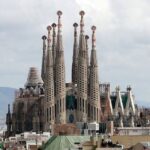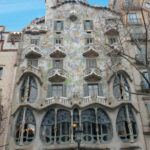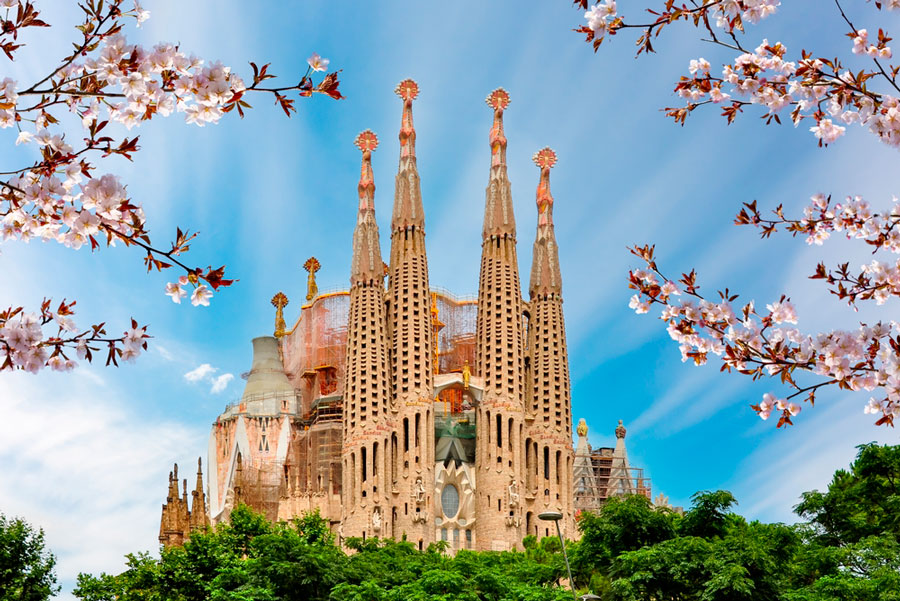
The Sagrada Familia, a basilica that embodies the imagination and artistry of Antoni Gaudí, has captivated visitors since its inception. Its unique architectural style combines Gothic and Art Nouveau elements, reflecting Gaudí's deep spiritual vision and innovation.
As we explore The Fascinating History of Sagrada Familia: From Concept to Iconic Landmark, we uncover the story of its ambitious design, the challenges faced during construction, and the enduring legacy that has made it a symbol of Barcelona and a UNESCO World Heritage Site.
The Architectural Vision Behind Sagrada Familia: Gaudí's Masterpiece
Antoni Gaudí's architectural vision for the Sagrada Familia is a testament to his profound understanding of nature and spirituality. He sought to create a structure that not only served as a place of worship but also as a reflection of God's creation. This vision is evident in the basilica's intricate details and organic forms, which draw inspiration from natural elements, such as trees and flowers. Gaudí's innovative use of geometry, particularly hyperboloids and parabolas, allows the building to achieve both structural integrity and aesthetic beauty.
The design of the Sagrada Familia incorporates various symbolic elements that represent key aspects of Christianity. Gaudí intended for each façade to narrate a different part of the biblical story. For example, the Nativity façade celebrates the birth of Christ, while the Passion façade reflects his suffering. Each element serves to educate visitors about the life of Jesus through a unique architectural language. Key symbolic features include:
- The Twelve Apostles represented on the Nativity façade
- The four evangelists showcased on the towers
- Numerous biblical references embedded in the structure
Moreover, Gaudí was a pioneer in the integration of light into his designs, which plays a crucial role in the overall atmosphere of the Sagrada Familia. He utilized stained glass windows to filter sunlight, creating a vibrant interplay of colors within the basilica's interior. The strategic placement of these windows not only enhances the spiritual experience but also emphasizes the intricate details of the stonework and sculptures that adorn the walls.
Finally, the Sagrada Familia is a reflection of Gaudí's commitment to sustainability and harmony with the environment. He designed the basilica to coexist with its surroundings, using local materials and techniques that minimized environmental impact. The harmonious blend of architectural innovation and ecological sensitivity marks the Sagrada Familia as not just a masterpiece of architecture, but as a forward-thinking monument that continues to inspire architects and visitors alike.
Unraveling the Symbolism: What Each Facade of Sagrada Familia Represents
The Sagrada Familia's facades are more than mere architectural features; they represent deep spiritual narratives. Each facade tells a distinct part of the Christian story, allowing visitors to embark on a journey through the life of Christ. This approach integrates both artistry and theology, transforming the basilica into a living testament of faith.
The Nativity facade, for instance, is rich with symbolism related to the birth of Jesus. It showcases intricate carvings of animals and flora, symbolizing the joy and innocence associated with new life. In contrast, the Passion facade presents a stark portrayal of Christ's crucifixion, characterized by its angular forms and somber expressions that evoke the suffering endured for humanity's redemption.
Additionally, the Glory facade, which remains under construction, aims to depict the glory of Jesus and the path towards salvation. Its design will integrate elements representing Heaven, the Resurrection, and the Divine, symbolizing the ultimate hope in Christian theology. Each facade not only serves a decorative purpose but also acts as a didactic tool, engaging visitors with its layered meanings.
In summary, the facades of the Sagrada Familia encapsulate Gaudí's visionary approach to architecture as a narrative form. By intertwining biblical themes with architectural innovation, Gaudí has created a complex dialogue between art and faith, making the Sagrada Familia a profound landmark that continues to inspire and educate.
The Construction Journey: Challenges Faced During Sagrada Familia's Building Process
The construction of the Sagrada Familia has been a remarkable journey, marked by numerous challenges that have tested the vision of its architect, Antoni Gaudí. From the outset, the project faced logistical difficulties, including the sourcing of materials and the need for innovative construction techniques. Despite these hurdles, the commitment to realizing Gaudí's vision has driven the project forward, making it a symbol of perseverance.
One of the most significant challenges encountered during the construction process has been the funding. The Sagrada Familia has been financed solely through private donations and ticket sales, which has led to intermittent periods of work. This reliance on public generosity has necessitated careful planning and adaptation to ensure continuous progress.
Additionally, the project has faced environmental and structural challenges due to its intricate design. The complex geometries demanded innovative engineering solutions, which were not fully understood at the time of Gaudí's death in 1926. Over the years, teams of architects and engineers have worked diligently to interpret his plans and apply modern technologies, ensuring that the building remains true to its original vision while addressing contemporary construction standards.
Furthermore, the Sagrada Familia has weathered political and social upheaval, particularly during the Spanish Civil War when much of Gaudí's original models and documents were destroyed. This loss posed a significant setback, yet it also sparked a renewed dedication among artisans and volunteers to reconstruct the iconic landmark according to Gaudí's spirit and intent. The ongoing construction reflects the communal effort and dedication that continues to define the Sagrada Familia project.
Cultural Significance of Sagrada Familia: A Landmark of Barcelona
The Sagrada Familia stands as a cultural symbol of Barcelona, attracting millions of visitors each year. Its towering spires and intricate designs not only showcase Antoni Gaudí's architectural genius but also reflect the city's rich heritage and artistic innovation. As a UNESCO World Heritage Site, it embodies the fusion of spirituality and creativity, making it a vital part of Barcelona’s identity.
Moreover, the Sagrada Familia serves as a catalyst for cultural exchange within the city. It draws tourists from around the globe, facilitating a dialogue between diverse cultures and fostering an appreciation for architectural artistry. The basilica's ongoing construction process has become a story of collective effort, involving local artisans and international supporters alike, thus reinforcing community ties and shared purpose.
Beyond its architectural significance, the Sagrada Familia plays a vital role in spiritual life for many. It is not only a tourist attraction but also an active place of worship, hosting religious ceremonies and events. This dual function enhances its importance as a landmark, bridging the gap between faith and artistic expression, and allowing visitors to experience a profound sense of connection to something greater.
In conclusion, the Sagrada Familia is more than just a stunning architectural feat; it represents the spirit of Barcelona and its commitment to preserving cultural heritage. Through its enduring legacy, it continues to inspire generations, making it an iconic landmark that resonates deeply with both locals and visitors alike.
Sagrada Familia's Evolution: From Concept to International Icon
The evolution of the Sagrada Familia from a mere architectural concept to an international icon is a testament to the vision and perseverance of its creator, Antoni Gaudí. Initially commissioned in 1882, the basilica was intended to be a humble church but quickly transformed under Gaudí’s influence into a grand masterpiece. His innovative designs not only encompassed religious themes but also incorporated elements of nature, making the structure an embodiment of both spirituality and creativity.
Over the decades, the Sagrada Familia has undergone substantial changes, driven by technological advancements and a deeper understanding of Gaudí's intentions. The construction process has been marked by various phases, each contributing to the overall complexity of the design. Despite interruptions due to political turmoil and funding challenges, the ongoing commitment to completing Gaudí's vision has turned the Sagrada Familia into a symbol of hope and resilience for many. Today, it is recognized as a UNESCO World Heritage Site, celebrated globally for its artistic and historical significance.
One remarkable aspect of the Sagrada Familia's evolution is its ability to adapt while remaining true to Gaudí’s original vision. The integration of modern engineering techniques has allowed for the continued construction of its intricate façades, ensuring that each detail faithfully represents the biblical narratives that inspired them. The basilica’s spires, once a distant dream, now reach skyward, marking the skyline of Barcelona and serving as a beacon of artistic achievement.
In conclusion, the Sagrada Familia's journey from concept to iconic landmark illustrates the fusion of artistry, spirituality, and community collaboration. It stands not only as a testament to Gaudí's genius but also as a reflection of Barcelona's cultural identity, inspiring awe in millions who visit each year. The ongoing work on the basilica continues to draw attention, making it a living symbol of the city’s rich heritage and an enduring legacy for future generations.
Visiting Sagrada Familia: Tips and Insights for Tourists
Visiting the Sagrada Familia is an awe-inspiring experience that requires some planning to make the most of your trip. One essential tip is to book your tickets online in advance. This not only saves time in long queues but also guarantees your entry at a preferred time. Additionally, consider opting for a guided tour to gain deeper insights into Gaudí's architectural vision, the symbolic elements, and the ongoing construction efforts that continue to shape this iconic landmark.
When you arrive, be sure to allocate sufficient time to explore both the interior and exterior of the basilica. The intricate details of the façades, especially the Nativity and Passion façades, are a feast for the eyes. To enhance your visit, try to experience the basilica at different times of the day, as the natural light filtering through the stained glass windows creates a stunning atmosphere that changes with the sun's position. Here are some additional tips:
- Visit early in the morning or later in the afternoon to avoid peak tourist crowds.
- Check for any special events or masses that may be taking place during your visit.
- Wear comfortable shoes, as you'll be doing a fair amount of walking.
Lastly, don't forget to explore the surrounding area of the Sagrada Familia. The nearby park and local cafes offer a great spot to relax and absorb the beauty of Gaudí's creation. If you're interested in local culture, consider visiting the nearby Hospital de Sant Pau, a UNESCO World Heritage Site, to further enrich your understanding of Barcelona's artistic and historical landscape. With these tips, your visit to the Sagrada Familia will be both enlightening and unforgettable.
 Is Sagrada Familia Worth It? A Must-Visit Monument in Barcelona
Is Sagrada Familia Worth It? A Must-Visit Monument in Barcelona ¿Por qué Casa Batlló es famosa?
¿Por qué Casa Batlló es famosa?If you want to know other articles similar to The Fascinating History of Sagrada Familia: From Concept to Iconic Landmark you can visit the category WHERE YOU CAN GO.
Leave a Reply










Read more!